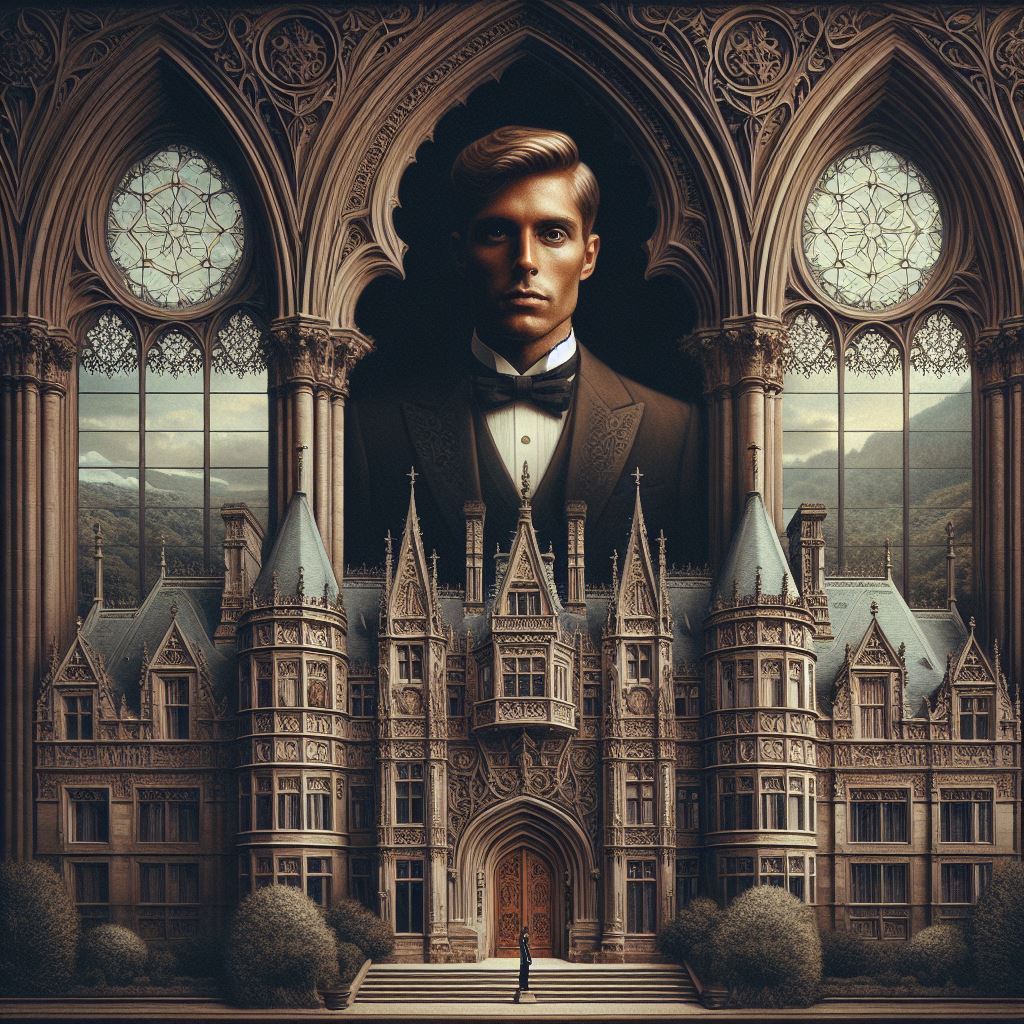Introduction
The Lyndhurst Mansion, nestled in the enchanting town of Tarrytown, New York, is a captivating example of the Gothic Revival architectural style.
With its steeply pitched roofs, pointed arches, and intricate ornamentation, the mansion stands as a testament to the grandeur of this unique architectural genre.
Beyond its visual appeal, Lyndhurst Mansion holds immense importance within the Gothic Revival architectural style.
Constructed in the mid-19th century, it played a vital role in popularizing the style in America.
Designed by Alexander Jackson Davis, a renowned architect of the time, the mansion served as a grand country estate for a series of notable owners, including railroad magnate Jay Gould.
The purpose of this blog post is to delve into the rich history and architectural significance of Lyndhurst Mansion.
As we explore its grand rooms, tranquil gardens, and ornate details, we will uncover the distinctive features that define the Gothic Revival style and their prominence within the mansion’s design.
Join us on this journey as we unlock the secrets behind Lyndhurst Mansion’s Gothic Revival glory.
Historical Background of Lyndhurst Mansion
Origins and construction of the mansion
The construction of Lyndhurst Mansion began in 1838 by architect Alexander Jackson Davis.
Davis incorporated Gothic Revival architectural style to create a picturesque and grand mansion.
The mansion was designed for William Paulding Jr., the former mayor of New York City.
Paulding wanted a luxurious and unique residence to showcase his wealth and social standing.
The construction was completed in 1864, and the mansion spanned over 67 acres of picturesque landscape.
Lyndhurst Mansion stands as an excellent example of Gothic Revival architecture in America.
Its majestic turrets, intricate ornamentation, and pointed arches are distinct characteristics of the style.
Transform Your Real Estate Decisions
Unlock personalized real estate insights crafted just for you. Get actionable advice designed to amplify your success.
Get StartedThe mansion is a testament to the craftsmanship and innovation of the 19th-century architects.
The construction of Lyndhurst Mansion was not only a grand project but also a symbol of societal prestige.
It symbolized the wealth and influence of the individuals who resided within its opulent walls.
Original owner and notable inhabitants
William Paulding Jr. was the original owner and first inhabitant of Lyndhurst Mansion.
Paulding was a prominent figure in New York City, serving as its mayor from 1824 to 1825.
After Paulding’s death, the mansion was purchased by George Merritt and later by Jay Gould.
Jay Gould, a railroad tycoon, made extensive renovations and additions to the mansion.
During Gould’s ownership, Lyndhurst Mansion became a social magnet, hosting elite gatherings.
Other notable inhabitants include Anna Gould, the daughter of Jay Gould, and her husband, Paul Ernest Boniface.
The mansion changed hands several times before being acquired by the National Trust for Historic Preservation in 1961.
Historical events and significance associated with the mansion
Lyndhurst Mansion witnessed important historical events and played a significant role in American cultural heritage.
It served as a backdrop for countless glamorous parties, gatherings, and social events during its heyday.
During the Gilded Age, Lyndhurst Mansion became a symbol of excess, luxury, and opulence.
The mansion’s architectural beauty and breathtaking landscape attracted artists and writers seeking inspiration.
Showcase Your Real Estate Business
Publish your company profile on our blog for just $200. Gain instant exposure and connect with a dedicated audience of real estate professionals and enthusiasts.
Publish Your ProfileThe famous author Washington Irving was a frequent visitor to the mansion, appreciating its Gothic charm.
Lyndhurst Mansion has been featured in several films and television shows, further enhancing its cultural significance.
Today, the mansion stands as a museum, preserving its historic and architectural legacy for future generations.
Thousands of visitors flock to Lyndhurst Mansion each year, experiencing its grandeur and learning about its rich history.
It serves as a testament to the historical importance of Gothic Revival architecture in American culture.
The mansion’s preservation allows us to appreciate and understand the cultural heritage of that era.
Lyndhurst Mansion is a true Gothic Revival gem that not only illustrates architectural brilliance but also holds a significant place in American history.
Its origins, notable inhabitants, and associated historical events make it a captivating destination for history enthusiasts and admirers of fine craftsmanship.
Read: Vizcaya: Miami’s Italianate Villa Explored
Architectural Features
Overview of Gothic Revival style
The architectural features of Lyndhurst Mansion exemplify the Gothic Revival style prevalent during the 18th and 19th centuries.
This movement sought to revive and emulate the design elements of medieval architecture, evoking a sense of romanticism and grandeur.
Description of exterior elements
The mansion’s exterior showcases various distinctive elements of the Gothic Revival style.
Pointed arches, a hallmark of the era, can be found throughout the building, adding an elegant and vertical touch.
Elaborate ornaments and traceries adorn the exterior walls, creating visually captivating patterns and intricate designs.
The steep sloping roofs contribute to the dramatic appearance of the mansion and enhance its verticality.
Turrets and towers grace the structure, commanding attention and emphasizing its grandeur.
The facade, intentionally asymmetrical and irregular, embraces the charm of Gothic architecture.
Description of interior elements
Once inside, visitors are greeted by a grand entrance hall that immediately captures their attention.
The hall features high ceilings that create a sense of space and openness, while ornate details and a sweeping staircase add a touch of elegance.
Stained glass windows, with their vibrant colors and intricate designs, infuse the rooms with a mesmerizing glow.
Elaborate woodwork and carvings, meticulously crafted, adorn the panels, moldings, and furnishings, showcasing the era’s craftsmanship.
The interior is further enhanced by decorative motifs and intricate patterns, creating an atmosphere of luxury and opulence.
The spacious rooms and high ceilings throughout the mansion contribute to a feeling of grandeur and offer ample space for social gatherings and leisure activities.
In fact, Lyndhurst Mansion stands as a testament to the captivating architectural features of the Gothic Revival style.
Its exterior elements, such as pointed arches, ornaments, and steep sloping roofs, along with turrets and an intentionally asymmetrical design, contribute to its charm.
The interior elements, including a grand entrance hall, stained glass windows, elaborate woodwork, decorative motifs, and spacious rooms, exude a sense of elegance and opulence.
This historic mansion serves as a remarkable example of the Gothic Revival movement and continues to captivate visitors with its Gothic glory.
Read: Castle in the Clouds: New Hampshire’s Gem
Renovations and Preservation Efforts
Overview of renovations throughout the years
The Lyndhurst Mansion has undergone several renovations to maintain its Gothic Revival glory.
Renovations were carried out periodically to restore the mansion to its original beauty.
Showcase Your Real Estate Business
Publish your company profile on our blog for just $200. Gain instant exposure and connect with a dedicated audience of real estate professionals and enthusiasts.
Publish Your ProfileOne of the most significant renovations took place in the 1960s to save the deteriorating structure.
The renovations included repairing damaged surfaces, replacing worn-out materials, and reinforcing the foundation.
Throughout the years, the mansion’s interior and exterior were meticulously restored to their former splendor.
Skilled craftsmen were hired to reproduce the intricate details and decorative elements of the Gothic Revival style.
Each renovation aimed to preserve the unique character and architectural significance of Lyndhurst.
The careful restoration work ensured that the mansion continued to stand as a testament to its rich history.
Renovations not only enhanced the mansion’s appearance but also made it structurally sound for future generations to enjoy.
The ongoing commitment to renovations has allowed Lyndhurst to remain a treasured landmark to this day.
Changes made to adapt the mansion to modern needs
In addition to renovations, certain modifications were made to make the mansion functional for modern use.
One of the notable changes was the installation of air conditioning and heating systems.
These modern upgrades ensured visitor comfort without compromising the historic charm of the mansion.
Modern amenities like updated restrooms and an elevator were discreetly incorporated to accommodate accessibility.
The introduction of advanced security systems helped protect the valuable artifacts and treasures within the mansion.
While adapting to modern needs, great care was taken to blend the new additions seamlessly with the original architecture.
The integration of these changes allowed Lyndhurst to continue as a functional space for various events and exhibitions.
By adapting to modern requirements, the mansion has stayed relevant and accessible to a wider audience.
The balance between preservation and adaptation has played a pivotal role in Lyndhurst’s continued success.
Importance of preservation efforts to maintain the mansion’s historical integrity
The preservation of Lyndhurst Mansion is crucial to protect its historical integrity.
Preservation efforts ensure that future generations can experience and appreciate the mansion’s unique heritage.
By conserving the mansion, we preserve a tangible link to the past and the stories it holds.
Lyndhurst’s architectural significance serves as a testament to the Gothic Revival movement in America.
The mansion’s preservation contributes to the collective memory and cultural fabric of the community.
Without preservation, the mansion’s historical value would be lost, and with it, an integral part of our heritage.
Preservation efforts allow for educational opportunities, enabling visitors to learn about architectural history.
Efforts to maintain the mansion also support the local economy by attracting tourism and generating revenue.
By valuing preservation, we demonstrate a commitment to preserving our heritage for future generations.
The ongoing preservation of Lyndhurst guarantees that this Gothic Revival masterpiece will continue to inspire and captivate for years to come.
Read: Filoli: Timeless Elegance in California

Lyndhurst Mansion as a Tourist Destination
Current uses of the mansion
The Lyndhurst Mansion, located in Tarrytown, New York, serves as a popular tourist attraction.
It is open to the public and offers various activities and events for visitors to enjoy.
Showcase Your Real Estate Business
Publish your company profile on our blog for just $200. Gain instant exposure and connect with a dedicated audience of real estate professionals and enthusiasts.
Publish Your ProfileThe mansion is a museum that showcases the architectural beauty and historical significance of the Gothic Revival style.
Visitors can explore the stunning interiors, including the grand entrance hall, bedrooms, and the magnificent art collection.
Guided tours and visitor experiences
Guided tours are available at the Lyndhurst Mansion, providing visitors with a comprehensive understanding of its rich history.
Knowledgeable guides share fascinating stories and insights about the mansion and its previous occupants.
Visitors can learn about the estate’s transformation and the legacy left behind by former owners, such as Jay Gould.
Interactive exhibits and multimedia presentations enhance the visitor experience, making it engaging and educational.
The tours include access to both the main house and the surrounding landscape, allowing visitors to appreciate the entire estate.
Special events and activities held at Lyndhurst Mansion
Lyndhurst Mansion hosts a variety of special events throughout the year, attracting visitors of all interests.
Art exhibitions, live performances, and cultural festivals showcase the vibrant arts and entertainment scene in the area.
Outdoor activities, such as garden tours and picnics on the expansive lawn, provide a peaceful retreat for nature enthusiasts.
Family-friendly events, like holiday celebrations and children’s workshops, offer fun-filled experiences for both adults and kids.
The mansion also serves as a beautiful venue for weddings, private parties, and corporate functions, adding a touch of elegance and sophistication.
In short, the Lyndhurst Mansion stands as a prominent tourist destination, offering a range of experiences for visitors.
From guided tours that delve into its intriguing history to immersive events that celebrate the arts, there is something to cater to all interests.
Whether exploring the exquisite interiors, enjoying outdoor activities, or attending special occasions, a visit to the Lyndhurst Mansion promises a memorable and enriching experience.
Read: The Mystery of Winchester Mystery House
Impact and Legacy of Lyndhurst Mansion
Influence on the spread of Gothic Revival architecture in the United States
Lyndhurst Mansion played a pivotal role in popularizing Gothic Revival architecture in the United States.
Built in 1838, it was one of the first grand-scale examples of this architectural style in the country.
The mansion’s dramatic spires, pointed arches, and intricate ornamentation became iconic symbols of the Gothic Revival movement.
Its design influenced countless architects and builders who sought to replicate its grandeur in towns and cities across America.
Lyndhurst’s impact on the spread of Gothic Revival architecture cannot be overstated, as it served as a blueprint for future projects.
Contribution to the preservation movement in historic buildings
Lyndhurst Mansion holds a significant place in the preservation movement as one of the earliest success stories.
In the late 1960s, the mansion faced the threat of demolition due to neglect and financial challenges.
However, concerned citizens and organizations rallied together to save this national treasure.
The successful preservation campaign for Lyndhurst became a model for future efforts to protect historic buildings.
It demonstrated that with community support and a dedicated preservationist approach, even the most endangered structures could be saved.
Local community and tourism benefits
Lyndhurst Mansion has had a profound positive impact on the local community and tourism industry.
The mansion attracts thousands of visitors each year, bringing economic benefits to Tarrytown, New York.
Tourists who come to see Lyndhurst also often explore other local attractions and contribute to the local economy.
The mansion serves as a cultural and educational hub, hosting various events, exhibitions, and programs for the community.
Showcase Your Real Estate Business
Publish your company profile on our blog for just $200. Gain instant exposure and connect with a dedicated audience of real estate professionals and enthusiasts.
Publish Your ProfileIts majestic grounds and stunning architecture provide a venue for weddings, parties, and other special occasions, further enriching the community.
In review, Lyndhurst Mansion’s impact and legacy are multifaceted, encompassing the spread of Gothic Revival architecture, the preservation movement, and the positive influence on the local community and tourism.
As an architectural inspiration, a preservation success story, and a community asset, it continues to inspire and benefit countless individuals.
The history and significance of Lyndhurst Mansion serve as a reminder of the importance of preserving our architectural heritage for future generations.
Conclusion
Nestled in Tarrytown, Lyndhurst Mansion epitomizes Gothic Revival’s grandeur, captivating visitors with its architectural marvels.
Embark on a journey through time and aesthetics. Lyndhurst’s ethereal charm beckons exploration, offering a glimpse into an era marked by opulence and innovation.
Unveiling the mansion’s historical tapestry, one cannot help but marvel at the meticulous craftsmanship and the indelible mark it leaves on architectural heritage.
A call to action resonates – visit Lyndhurst, for it’s more than a mansion; it’s a living testament to the creative ingenuity of a bygone era.
In addition, Lyndhurst Mansion stands as a beacon of Gothic Revival glory, preserving the spirit of an epoch in its stone walls and ornate details.
Each room narrates a story, each corridor whispers secrets of a time when craftsmanship met extravagance.
To witness this living piece of history firsthand is not merely an option; it is an essential pilgrimage for those who appreciate the convergence of art and architecture.
Lyndhurst beckons, inviting enthusiasts to immerse themselves in an era where opulence met innovation.
As the sun sets, casting an amber glow upon Lyndhurst’s spires, one cannot help but feel the echoes of a past era.
This Gothic masterpiece is not frozen in time but alive, pulsating with the essence of its creation.
Dear reader, seize the opportunity to traverse through Lyndhurst’s halls, to breathe in the whispers of the past.
Explore its Gothic splendor, and let history unfold before your eyes.
Lyndhurst Mansion awaits, an architectural symphony that resonates through time.
Visit, experience, and become part of its ongoing narrative. The call to action is clear – let Lyndhurst enchant you.



